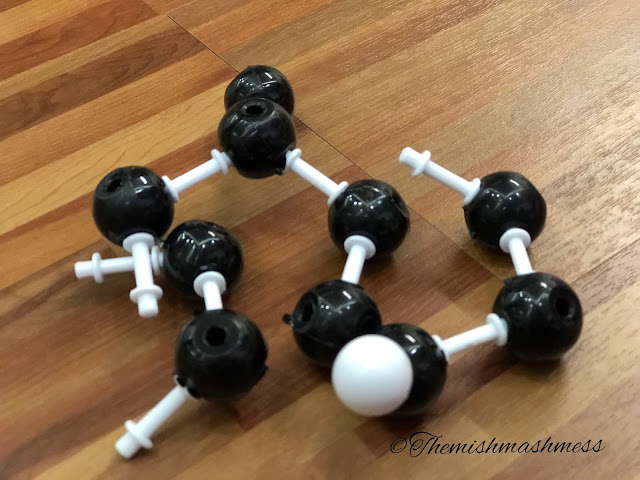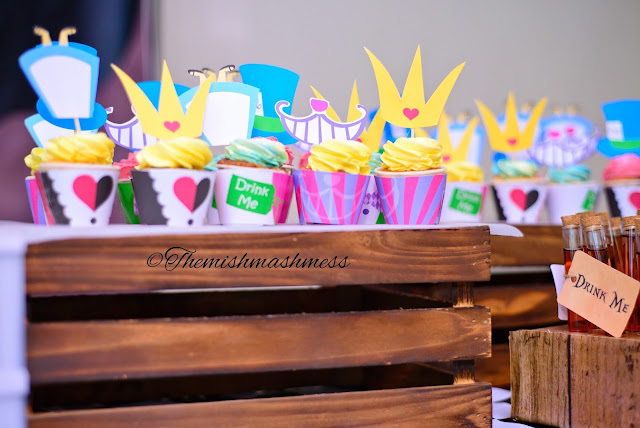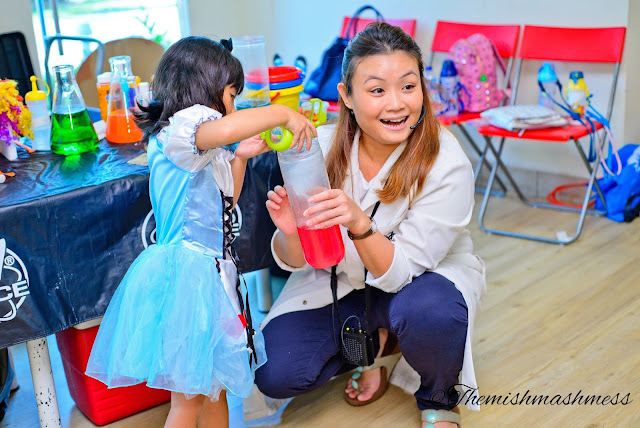
Big K has been complaining that mama here doesn't do Science with her. Truth be told, we do, but on an ad hoc basis and she basically doesn't know that is Science. More importantly, we seldom go beyond the usual baking powder and vinegar experiment. Oops. When we were invited for this holiday Science Escapade by Cognitive Whizz, I was thrilled as she would have an opportunity to conduct experiments without messing up my house.
DAY ONE
It was a morning camp and it was quite tough getting Big K in the mood initially as she doesn't wake up early. (good luck to me next year!) During the ice-breaker session where children were supposed to introduce themselves, Big K was huddling with a teacher in a corner. I was worried that Science may not be her cup of tea. Next, I flipped through the worksheet and was stunned! JAW-DROPPING to be honest. The topics which were going to be covered were electricity, centre of gravity, surface tension, protons and neutrons just to name a few. Would these 4 to 8 year olds understand? How are they going to communicate such big topics to these little children?
At the start of each day, our facilitator, Denise flipped flashcards on emotions. It isn't your usual happy, sad, angry and sad. To expand the little sponges' vocabulary, they covered words like ecstatic, downhearted, alarmed and jealous. After which, they asked students to describe their feelings and to give a reason. Surprisingly, many students were able to quote a suitable example to match their feelings. I was convinced then that it is never too young to beef up a child's vocabulary. These days, with creative writing being more creative, one way to score is to use a variety of words and work on your sentence construction.


A story on Cinderella followed suit. At this point, I was wondering if I was in a Science or English lesson. In actual fact, it was a clever use of Cinderella. They incorporated the feelings which were taught earlier eg. Cinderella was ecstatic when she learnt about the ball. She was however downhearted when her unkind stepmother did not allow her to go, despite how hard she works. Her stepsisters were jealous of her, as she was very attractive. When she finally got to go to the ball, and met the prince, she was ecstatic and got carried away. She was alarmed when the clock struck 12. By incorporating the words into the story, it makes it more interesting and imprinted it into the children's minds. To make it less dry, they included a role-play section where students acted out the story. Many volunteered to be Cinderella and no one wanted to be the stepmother. A student donned on a Cinderella costume and started pretending to sweep and mop the floor whilst wearing a beautiful light up shoe. Now, this was a clever move as the lesson was about electricity! To introduce the concept, the little children were told that they were going to be transformed into little fairy Godmothers, each holding a colourful wand, saying the magic word out loud "Static electricity! Static electricity!"
Such a clever way to engage students!
Following that, some experiments were conducted. Cinderella was exhausted after all the chores and she found a rainbow duster which cheered her up! She became downhearted when she realized that the duster was unable to trap the tinsel. The children were asked to think of solutions but they couldn't. Finally the teacher revealed that if the children rubbed the tinsel with cloth, the action actually got the tinsel to attract to the static duster! That got all the children excited!
To further excite the little ones, the children were asked to rub the balloons on their hair to create a new hairstyle for themselves! The underlying principle was that when the atom has the same number of protons and electrons, the atom is neutral ie. no charge. Rubbing causes friction and enables the electrons to be transferred. When there is an imbalance of protons and electrons, the atom is 'charged'. When the balloon was rubbed on the head, electrons moved from the head to the balloon. They piled up on the side of the balloon near the hair. The hair has not less electrons (-) and more protons (+), hence is positively charged! WOW! What a mouthful right? If these children were simply told of the facts, I doubt they would understand. Hence, the team illustrated the concept through visual representation. They had 3 teachers standing inside a hula hoop (nucleus), pretending to be protons. Another 3 teachers were the electrons moving around the nucleus (containing the protons). They represent the atom of a hair. Similarly, there were 3 students standing within a hula hoop, pretending to be protons of a balloon and another, moving around the nucleus, pretending to be the electrons of a balloon. As the balloon is rubbed on the hair, one of the electrons (a teacher) moved to the balloon, now the number of protons and electrons are not balanced anymore. The balloon has more electrons and the hair less electrons. Both atoms now have opposite charges and will attract! To illustrate this, the teachers and children hugged one another!


Experiment number 3:
Picking styrofoam beads with hands!
Oh no! Someone spilled the styrofoam beads! They were scattered all over! How can the children help Cinderella to clean up?
Answer: Applying the concept of electron flow, the children were able to show the teachers how the beads got attracted and stayed on their hands!
Sensory + Science! SCORE!
So why should children this age learn about protons and neutrons if they can't apply? Well, the do! Think of lightning! It is due to charges being build up at the clouds. As the negative charges in the cloud build up, they get attracted to the positive charges on the ground. Lightning strikes when the negative charge from the cloud connects with the positive charge on the ground! See Application!
Next, Current Electricity was introduced to the children. They were told that "static" means not moving and when the electrons moved around, there is current electricity.

The children had a visual of it through the energy stick. When the children placed both their hands on the stick (depicting a closed circuit), it sounded like an alarm. It stopped sounding when only one hand is placed. To further demonstrate, the children started holding hands to form a closed circuit with the energy stick. They realised that when any child stopped holding hands, the circuit is broken and the alarm stopped sounding. They were further told about what a good conductor and insulator is. The children tried holding another child's clothes instead of hands, and the stick stopped sounding. Hence they discovered that electricity cannot flow through the cloth. The children were given a chance to predict which other objects allow electricity to pass through, then validated their predictions with the energy stick. They realised that the stick only sounded with metals while non-metals typically do not allow electricity to pass through. This is certain a very fun way of communicating the concept to a little child. A concept which they can apply to their daily lives and they may better understand why they shouldn't touch a switch with their wet hands.



Lastly, they applied their knowledge of close circuit and conductors to build a robot cleaner for Cinderella! I was pleasantly surprised that Big K was asking questions and trying to fix up the robot on her own. In the past, she often rely on others to do it for her, refusing to try. However, perhaps due to peer pressure (and the fact that mummy wasn't around), she tried.
DAY TWO
The day started with a recap of the words the children were taught the day before. The word ecstatic seemed to be etched deeply in their minds. Denise continued to input new words to describe their emotions and that followed by a story of The Animal Singers of Bremen.
The focus of day two was on the concept of centre of gravity. Students were asked where their centre of gravity was. Big K definitely caught on this concept fast because when we went home that night, she was demonstrating what she learnt to me. I thought that was a one off, but a few days later, when her papa brought her to a playground to climb a wall, she couldn't balance and told the father ," papa, my centre of gravity has been shifted so I am falling. But don't worry, i will keep trying because nothing is impossible if you put your mind to it". I kid you not! Those were the exact words coming from my 6 year old. I was touched beyond words! All my teachings hadn't gone to waste!
Experiment: Making a Stuntsman
The children were shown a paper tightrope walker. It was unable to balance itself across the rope. How can the children help him?
There were many excellent suggestions from the children, applying and validating the concepts they just learnt. One child said "because his centre of gravity is low now"! Kids really learn so fast these days! I am impressed!
The children also tried balancing a can on the table! Big K came home asking me for empty cans and was so enthusiastic to show me what she had learnt.
For some hands-on activities, children got to make their own rolly pollies. They were asked what makes a Rolly Polly so stable that it can never fall! The children got to dismantle the Rolly Polly and discover the answers for themselves.
Other concepts introduced were forces and inertia. To help reinforce, the children had to gesture that a force is a push (move backwards) or a pull (move forward). Big K came home doing this with her little brother.
Once again, I was initially skeptical as to why my child should be taught such bombastic concepts, however upon deeper analysis, concepts like centre of gravity and inertia is applicable to our daily lives. Like when we are at the swimming pool, we could remind our children not to lean over the pool and ask them what happens to their centre of gravity when they do so. As for inertia, it is all around too! Everything around us are stationary. Once they start moving, a force needs to stop them. WHen the child is able to see all these connections, they will appreciate their environment better, and nurture their passion in learning!
DAY THREE
The lesson opened with a story on The Dreamy Milkmaid and as usual, Denise cleverly related the emotions to the characters of the story.
It was shared that milk contains mostly water and some fats, proteins and sugar present in milk as molecules. The milk molecules at the surface are holding on to one another tightly. They do not want to separate. Children were engaged in various experiments which demonstrated surface tension. One of which was to add dish soap to a bowl of milk which had colours in it. The swirling of colours showed the movement of dish soap rapidly surrounding and trapping the fat. It was reinforced with the children that milk contains a lot of fats, making their cups and bottles oily. Hence, we need dish soap to wash these dirty cups and bottles.
More experiments were conducted to help children reinforce the concept of surface tension. For instance, getting the children to predict, then count the number of water droplets a coin can hold, and how surface tension can help dense objects float.
Once again, this can be applicable to our daily lives: Pond skaters and water striders are able to walk across ponds, by resting their feet on the "skin" of the water surface. Ok, looks like we need to visit some pond soon!
Transforming milk into curd and whey!
I think this is really cool. The children were showed what will happen in their stomach when fruits are taken in with milk. First, the children had to smell vinegar (sensory), all of them do not like the smell! Then the milk and vinegar were mixed and heated. The children observed that the milk curdled, I.e. lumps started forming when mixed with vinegar, and upon heating, some shared it smelled like cheese or vomit!
A strainer was used to filter off the solid lumps (curd) from the liquid (whey). The children were encouraged to feel the lumps and they all enjoyed it saying it felt like playdoh.
The clumps of curd contain casein, a milk protein. Of course the word 'casein' wasn't introduced to the children. It would have been too much. Milk is transformed into curd and whey when mixed with acid as protein in the milk does not mix with the acid. The curd can be moulded like plastic.
Transforming milk protein (casein) into glue!
Add baking soda to the curd, it neutralizes the acid! Some bubbles may form - these are bubbles of carbon dioxide. AHHHHH something we are familiar with!! However, we didn't know that this could actually stick papers together. Nice discovery for Big K and I.
FINAL DAY
Big K shared with me that this was the most exciting day for her. Because, the story of FROZEN was read to her! All the words learnt during the course of this Science escapade were incorporated into the story. There was even a twist in the story hence the children were all intrigued.
The children were reminded that everything around us are made up of atoms. Atoms combine to form molecules. They were showed (both 2D and 3D) that 2 oxygen atoms combine to form an oxygen molecule. 2 Hydrogen and 1 Oxygen atom combine to form a water molecule. When long chain of molecules with complex structures combine, they form polymers.
Highlight of the day: they were showed how snow polymers look like, and that the snow polymers were very thirsty! The children were asked what would happen if we feed the snow polymers with water. Most shared that it will become a snowball! Some children asked how to get the water out after that! Curiosity had peaked!
So they progressed to make snowballs. 2 scoops of snow polymer were added and the children were awed to watch the polymer immediately balloon up! They all got excited feeling fake snow. Some said it felt cold and squishy and some said it felt like slime! What happened was that the water molecules travelled from outside the polymer to the inside, making it swell. This is a fantastic sensory opportunity for children.
It was later revealed that the snow polymer is akin to the absorbent polymers found in diapers! The children were amazed but were able to connect that their pee was being absorbed in a similar way.
Experiment: Power of Salt Water
Some children asked earlier how to get the water from the expanded snow polymers out again. They asked the children what if salt water is now added. Will the expanded snow polymers "drink up" the salt water too?
Some salt water were added to the expanded snow polymers and the water inside flowed out! This was actually to demonstrate the concept of OSMOSIS! Another big concept for a child but look how the facilitators were able to slowly weave it in without making it overwhelming.

It was quite a surprise how huge concepts were communicated to children aged 4 to 8.
Cognitive Whizz made use of visual representations and multi-sensory experiments as well as games to engage the children. I was very appreciative that a debrief was given after every session. We as parents should follow up to make it more fruitful. Also, Denise went an extra mile to text us the various concepts learnt after everyday. It was extremely detailed. Big K was said to be actively participating after day 1, shouting out the answers and participating keenly during the quiz. In fact, she came out proudly, announcing that she won herself a bar of chocolate! Proud of you, my baby! While I noted that some children were tired towards the end of the lesson (probably because of the influx of information), most children were bubbling with energy. Too much of it, like electrons in fact, which explained why they needed 7 teachers to control the crowd. I thoroughly enjoyed this holiday workshop and believe the children had a good time too!
Cognitive Whizz believes in engaging young children in holistic joyful learning, to stimulate inquisitive minds and maximize their learning capacities. It is their belief (and mine) that parents are children's best teachers. Regular parent-child bonding is the key enabler for a complete metamorphosis to take place. Children are born inquisitive, and love to explore the world. Cognitive Whizz seeks to satisfy their learning desires, with visually appealing and information-rich education resources, and interactive holistic learning programs.
A Science Escapade is professionally developed as an immersive, research-based programme. Children are encouraged to explore and inquire in a nurturing environment; hypothesize, observe then evaluate data to form their own conclusions. This helps to inculcate in the young children an inquiry mindset that will prepare them for success in life.
For more information, check out their facebook page
here for more of their workshops! You may also contact 90097086 or email
info@cognitivewhizz.com to find out more!
DISCOUNT CODE
Keen to expose your children to intriguing Science concepts through holistic joyful learning, quote MMM20 for a $20 discount off the next Science Escapade in June 2018! Never too early to plan!
Disclaimer: We were invited to a 4Day holiday workshop for this review. In accordance to the company's wishes, the answers to certain questions were removed. The results for each student is subjective. No additional monetary compensation was received. All opinions expressed are entirely my own and written according to my experience in using the products/ services.
























































































































